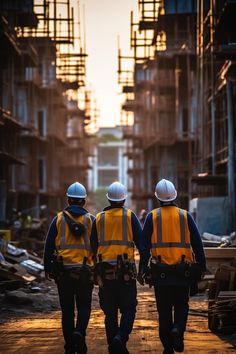The Hidden Framework: Why Modern Formwork Systems Are Revolutionizing Commercial Construction
When people think about skyscrapers, malls, or industrial complexes, they rarely think about what goes into shaping those massive concrete columns, walls, and slabs. But behind every soaring structure lies a temporary but critical backbone—the formwork. Traditionally seen as just a means to an end, formwork systems have undergone a silent revolution in recent years. Today, modern formwork systems are not just support structures; they are productivity-boosting, safety-enhancing, and cost-cutting game changers in commercial construction.
Let’s peel back the layers of this “hidden framework” and explore why modern formwork systems are quietly transforming the commercial construction landscape.
What is Formwork, and Why Does It Matter?
Formwork is the temporary or permanent mold into which concrete is poured to set and cure. In commercial projects, formwork is used to shape everything from columns and beams to slabs and stairwells. Without it, there would be no structure—quite literally.
Traditionally, timber and plywood were the go-to materials. While cost-effective upfront, these conventional systems were labor-intensive, time-consuming, and offered little in the way of precision or repeatability. Enter modern formwork systems—modular, engineered, and made of aluminum, steel, or plastic composites. These systems are reshaping the industry by offering better safety, faster cycles, and higher-quality finishes.
-
Speed: Reducing Construction Timeframes
In commercial construction, time is money. One of the standout advantages of modern formwork is the dramatic reduction in cycle time.
Prefabricated modular formwork systems allow crews to assemble and disassemble structures faster than traditional wooden forms. Systems like table formwork or tunnel formwork enable rapid setup and reuse, particularly for repetitive floor layouts in commercial buildings.
According to research by the National Institute of Building Sciences, modern formwork systems can reduce construction time by up to 30% compared to traditional methods (source).
This isn’t just about finishing faster—it’s about gaining a competitive edge. In the commercial world, earlier project delivery can mean earlier rental income, faster handover to clients, and reduced financing costs.
-
Precision and Quality: Raising the Bar
Modern formwork systems are designed with precision engineering. Unlike timber that can warp or swell, steel and aluminum systems offer consistent dimensions and tight tolerances. This translates into smoother finishes, straighter lines, and fewer defects.
Less finishing work means lower labor costs and fewer materials like plaster or skim coat, especially in visible concrete applications such as exposed columns or atriums. Architects and developers are increasingly relying on these systems to achieve high-end finishes with minimal rework.
Furthermore, systems like climbing formwork allow high-rise structures to be built with an uninterrupted pour sequence, reducing cold joints and improving overall structural integrity.
-
Safety: Creating Safer Job Sites
Formwork accidents are not uncommon, especially when makeshift wooden systems are used under pressure to save costs. Modern formwork is engineered for safety. These systems come with integrated platforms, ladders, guardrails, and load-bearing certifications that reduce the risk of on-site injuries.
According to a study from the Center for Construction Research and Training, the adoption of engineered formwork systems reduces formwork-related accidents by nearly 40% (source).
Not only does this protect lives, but it also helps contractors stay compliant with safety regulations, avoid costly delays from investigations, and reduce liability insurance premiums.
-
Sustainability: Reducing Material Waste
Green building practices are no longer optional—they’re expected. Reusability is one of the greatest sustainability benefits of modern formwork. Steel and aluminum formwork can be reused 50 to 200 times with minimal degradation, compared to timber which might only last 5 to 10 cycles before it’s discarded.
In addition, many modular systems are compatible with Building Information Modeling (BIM), allowing teams to plan exact quantities and dimensions. This means less cutting on-site, less offcut waste, and more efficient material logistics.
Plus, less remedial work means fewer resources spent on sanding, plastering, and painting. It all adds up to a lower environmental footprint over the lifecycle of a project.
-
Labor Efficiency: Doing More With Less
The construction industry continues to grapple with labor shortages, especially in developed markets. Modern formwork systems are designed to be intuitive and modular, reducing the need for highly skilled carpenters or large crews.
Many systems use a “plug-and-play” method where panels snap or lock into place, allowing general laborers to set them up under supervision. Some even come with hydraulic systems to lift the formwork automatically, minimizing crane dependency.
With one trained crew, a contractor can achieve what would traditionally require multiple teams working in tandem. This is crucial in commercial projects where different subcontractors are often juggling tight schedules.
-
Cost Control: Saving Beyond Materials
While modern formwork systems come with higher initial costs, the long-term savings are significant. The faster setup, reduced labor, fewer reworks, and high reusability lead to major reductions in the overall cost per square meter of formwork.
Let’s break that down:
- Material reuse: Instead of buying timber multiple times, one set of panels can last for dozens of pours.
- Labor cost: Fewer workers needed = lower payroll bills.
- Reduced rework: With precise molds, there’s less patching, chipping, and repair work.
- Faster completion: The earlier you finish, the sooner you hand over or rent out the building.
These cumulative savings can make or break a tight-margin commercial project, especially in competitive bidding scenarios.
-
Innovation and Integration with Technology
Modern formwork systems are now being designed with technology in mind. Some companies are embedding sensors into formwork panels to monitor concrete curing conditions, temperature, and load stresses in real time.
This data allows project managers to optimize timing for striking (removing) the formwork, ensure safety, and monitor quality. It’s a great example of how construction is evolving into a more digitized, data-informed process.
Additionally, software platforms can now simulate the formwork process in a 3D environment before a single panel is installed. These digital rehearsals reduce errors, coordinate timelines, and improve communication across teams.
-
Flexibility Across Projects
Commercial construction projects vary wildly—from office towers to hospitals to parking garages. Modern formwork systems are adaptable enough to suit all these different use cases. Some systems are adjustable to different heights and thicknesses. Others can curve to form domes, arches, or non-linear shapes.
This design flexibility means one formwork system can be used across multiple projects, increasing its return on investment over time. For contractors, that’s a huge advantage.
Conclusion: The Future Is Modular, Safe, and Smart
The old-school mindset of “we’ve always done it this way” is no longer competitive in commercial construction. As deadlines shrink, costs rise, and safety regulations tighten, modern formwork systems offer a quiet revolution in how we build.
What was once just temporary scaffolding for concrete is now a strategic asset—speeding up projects, improving quality, protecting workers, and saving money. With the added benefits of sustainability, technology integration, and precision, these systems are setting a new industry standard.
So next time you walk past a construction site, take a closer look at the molds behind the walls. You might just be looking at the future of commercial construction—one panel at a time.
- The Hidden Framework: Why Modern Formwork Systems Are Revolutionizing Commercial Construction
- Discover how advanced form work systems are transforming commercial construction by improving efficiency, safety and cost effectiveness.
- Modern form works, commercial construction technology, building efficiency, sustainable construction
Related posts:
 Why KBH Games Is Perfect for Family-Friendly Online Entertainment
Why KBH Games Is Perfect for Family-Friendly Online Entertainment
 High-Quality Biomedical Waste Incinerators & Laboratory Glassware Made in India
High-Quality Biomedical Waste Incinerators & Laboratory Glassware Made in India
 Understanding the Role of IoT in Modern Manufacturing: A Comprehensive Guide to Smart Factories and Industrial Transformation
Understanding the Role of IoT in Modern Manufacturing: A Comprehensive Guide to Smart Factories and Industrial Transformation
 Best Account Management Software for All Businesses – EmizenTech
Best Account Management Software for All Businesses – EmizenTech
 Top 15 Global Website Design Companies You Can Hire in the 2025
Top 15 Global Website Design Companies You Can Hire in the 2025
 Unlocking Customer Insights with Video Analytics in Retail Industry
Unlocking Customer Insights with Video Analytics in Retail Industry
 Empowering Qatari Retail Businesses with Microsoft Dynamics 365 Commerce
Empowering Qatari Retail Businesses with Microsoft Dynamics 365 Commerce
 Low Voltage Solutions for Commercial Developers – SecureTech Systems
Low Voltage Solutions for Commercial Developers – SecureTech Systems







